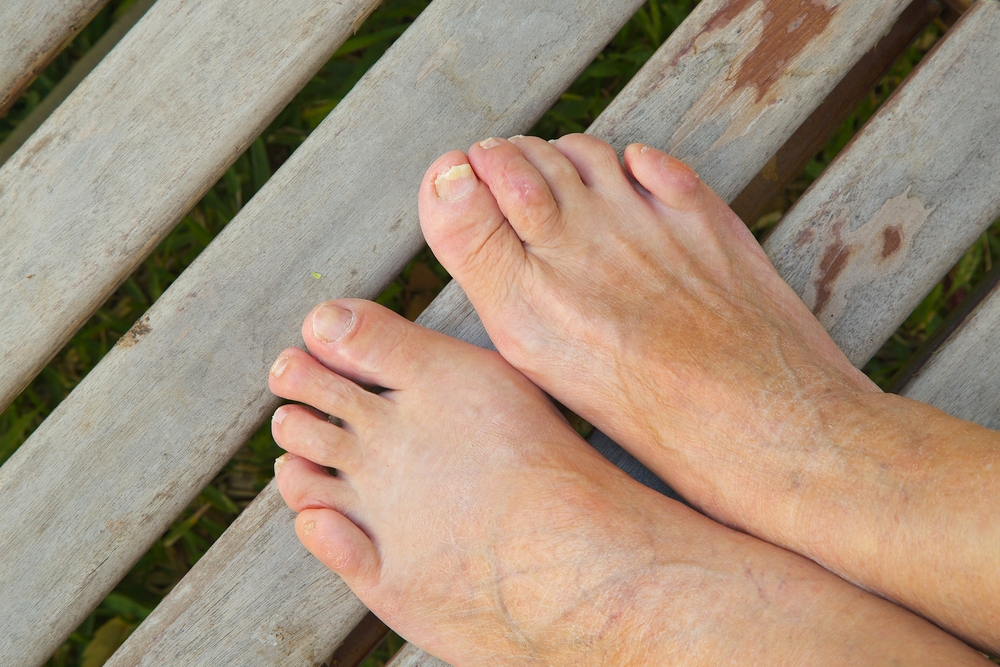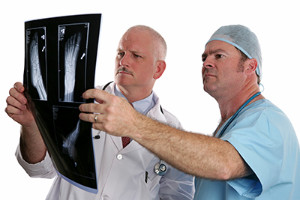Connect With Us
Blog
Why Do I Have Hammertoes?
 Hammertoe is a common foot deformity in which the toes bend downward at the middle joint, creating a hammer-like shape. This deformity typically affects the second, third, or fourth toes and causes pain, discomfort, and joint stiffness. There are many reasons why a hammertoe may develop. Chronically wearing ill-fitting shoes which are too tight, narrow, have excessively high heels, or squeeze your toes together, can contribute to the formation of hammertoes. Hereditary foot differences, having unusually long toe bones, weakness in the muscles of the feet, or injuries can also make hammertoes more likely. Other foot conditions, including bunions and rheumatoid arthritis, may increase your risk of hammertoes. If you notice that your toes are changing in appearance, or if you are experiencing any foot pain, please seek the care of a podiatrist. Treating hammertoes early can help stop or slow their progression.
Hammertoe is a common foot deformity in which the toes bend downward at the middle joint, creating a hammer-like shape. This deformity typically affects the second, third, or fourth toes and causes pain, discomfort, and joint stiffness. There are many reasons why a hammertoe may develop. Chronically wearing ill-fitting shoes which are too tight, narrow, have excessively high heels, or squeeze your toes together, can contribute to the formation of hammertoes. Hereditary foot differences, having unusually long toe bones, weakness in the muscles of the feet, or injuries can also make hammertoes more likely. Other foot conditions, including bunions and rheumatoid arthritis, may increase your risk of hammertoes. If you notice that your toes are changing in appearance, or if you are experiencing any foot pain, please seek the care of a podiatrist. Treating hammertoes early can help stop or slow their progression.
Hammertoe
Hammertoes can be a painful condition to live with. For more information, contact one of our podiatrists from Foot & Ankle Associates of Maine. Our doctors will answer any of your foot- and ankle-related questions.
Hammertoe is a foot deformity that affects the joints of the second, third, fourth, or fifth toes of your feet. It is a painful foot condition in which these toes curl and arch up, which can often lead to pain when wearing footwear.
Symptoms
- Pain in the affected toes
- Development of corns or calluses due to friction
- Inflammation
- Redness
- Contracture of the toes
Causes
Genetics – People who are genetically predisposed to hammertoe are often more susceptible
Arthritis – Because arthritis affects the joints in your toes, further deformities stemming from arthritis can occur
Trauma – Direct trauma to the toes could potentially lead to hammertoe
Ill-fitting shoes – Undue pressure on the front of the toes from ill-fitting shoes can potentially lead to the development of hammertoe
Treatment
Orthotics – Custom made inserts can be used to help relieve pressure placed on the toes and therefore relieve some of the pain associated with it
Medications – Oral medications such as anti-inflammatories or NSAIDs could be used to treat the pain and inflammation hammertoes causes. Injections of corticosteroids are also sometimes used
Surgery – In more severe cases where the hammertoes have become more rigid, foot surgery is a potential option
If you have any questions please contact our office located in Brunswick, ME . We offer the newest diagnostic and treatment technologies for all your foot and ankle needs.
Are Corns Painful?
 The main reason that corns develop is often due to excess friction. This can happen from wearing shoes that do not fit correctly. Corns can form on different parts of the foot. A soft corn is found between the toes, and can cause severe pain and discomfort. A hard corn can develop on the outside of the toe, or on the bottom of the foot. People who are diabetic may have a higher risk of developing an infection with corns. Patients have found mild relief when the affected foot is soaked in warm water, followed by using a pumice stone. It is beneficial to wear shoes that fit properly, as this may help to prevent the onset of corns. If you have a corn on any part of your foot, please consult with a podiatrist who can determine what the best course of treatment is for you.
The main reason that corns develop is often due to excess friction. This can happen from wearing shoes that do not fit correctly. Corns can form on different parts of the foot. A soft corn is found between the toes, and can cause severe pain and discomfort. A hard corn can develop on the outside of the toe, or on the bottom of the foot. People who are diabetic may have a higher risk of developing an infection with corns. Patients have found mild relief when the affected foot is soaked in warm water, followed by using a pumice stone. It is beneficial to wear shoes that fit properly, as this may help to prevent the onset of corns. If you have a corn on any part of your foot, please consult with a podiatrist who can determine what the best course of treatment is for you.
Corns can make walking very painful and should be treated immediately. If you have questions regarding your feet and ankles, contact one of our podiatrists of Foot & Ankle Associates of Maine. Our doctors will treat your foot and ankle needs.
Corns: What Are They? And How Do You Get Rid of Them?
Corns are thickened areas on the skin that can become painful. They are caused by excessive pressure and friction on the skin. Corns press into the deeper layers of the skin and are usually round in shape.
Ways to Prevent Corns
There are many ways to get rid of painful corns such as:
- Wearing properly fitting shoes that have been measured by a professional
- Wearing shoes that are not sharply pointed or have high heels
- Wearing only shoes that offer support
Treating Corns
Although most corns slowly disappear when the friction or pressure stops, this isn’t always the case. Consult with your podiatrist to determine the best treatment option for your case of corns.
If you have any questions please feel free to contact our office located in Brunswick, ME . We offer the newest diagnostic and treatment technologies for all your foot and ankle needs.
Do Your Child's Feet Hurt?
What Podiatrists Can Do
 Podiatrists are doctors that specialize in treating conditions that affect the feet of children, adults, and seniors. They can treat infections, provide pain relief, correct deformities, and help to heal broken bones. Podiatrists help treat specific conditions such as diabetes, ingrown toenails, flat feet, bunions, heel pain, blisters, athlete’s foot, cracked heels and so much more. Podiatrists are also able to prescribe orthotics, which are typically custom made shoe inserts, in order to relieve pressure from problem areas on the feet. Podiatrists can help you pick proper footwear to prevent a variety of foot and ankle conditions from developing. They can also help you choose the correct walking or running shoe too. If you have a foot problem that you are unsure about or are experiencing any type of foot pain, a podiatrist is trained to help find a diagnosis and provide proper treatment for your specific condition.
Podiatrists are doctors that specialize in treating conditions that affect the feet of children, adults, and seniors. They can treat infections, provide pain relief, correct deformities, and help to heal broken bones. Podiatrists help treat specific conditions such as diabetes, ingrown toenails, flat feet, bunions, heel pain, blisters, athlete’s foot, cracked heels and so much more. Podiatrists are also able to prescribe orthotics, which are typically custom made shoe inserts, in order to relieve pressure from problem areas on the feet. Podiatrists can help you pick proper footwear to prevent a variety of foot and ankle conditions from developing. They can also help you choose the correct walking or running shoe too. If you have a foot problem that you are unsure about or are experiencing any type of foot pain, a podiatrist is trained to help find a diagnosis and provide proper treatment for your specific condition.
If you are experiencing pain in the feet or ankles, don’t join the stubborn majority refusing treatment. Feel free to contact one of our podiatrists from Foot & Ankle Associates of Maine. Our doctors can provide the care you need to keep you pain-free and on your feet.
What Is a Podiatrist?
Someone would seek the care of a podiatrist if they have suffered a foot injury or have common foot ailments such as heal spurs, bunions, arch problems, deformities, ingrown toenails, corns, foot and ankle problems, etc.
Podiatric Treatment
A podiatrist will treat the problematic areas of the feet, ankle or lower leg by prescribing the following:
- Physical therapy
- Drugs
- Orthotic inserts or soles
- Surgery on lower extremity fractures
A common podiatric procedure a podiatrist will use is a scanner or force plate which will allow the podiatrist to know the designs of orthotics. Patients are then told to follow a series of tasks to complete the treatment. The computer will scan the foot a see which areas show weight distribution and pressure points. The podiatrist will read the analysis and then determine which treatment plans are available.
If you have any questions please feel free to contact our office located in Brunswick, ME . We offer the newest diagnostic and treatment technologies for all your foot and ankle needs.

